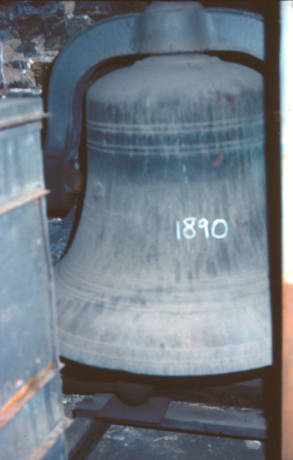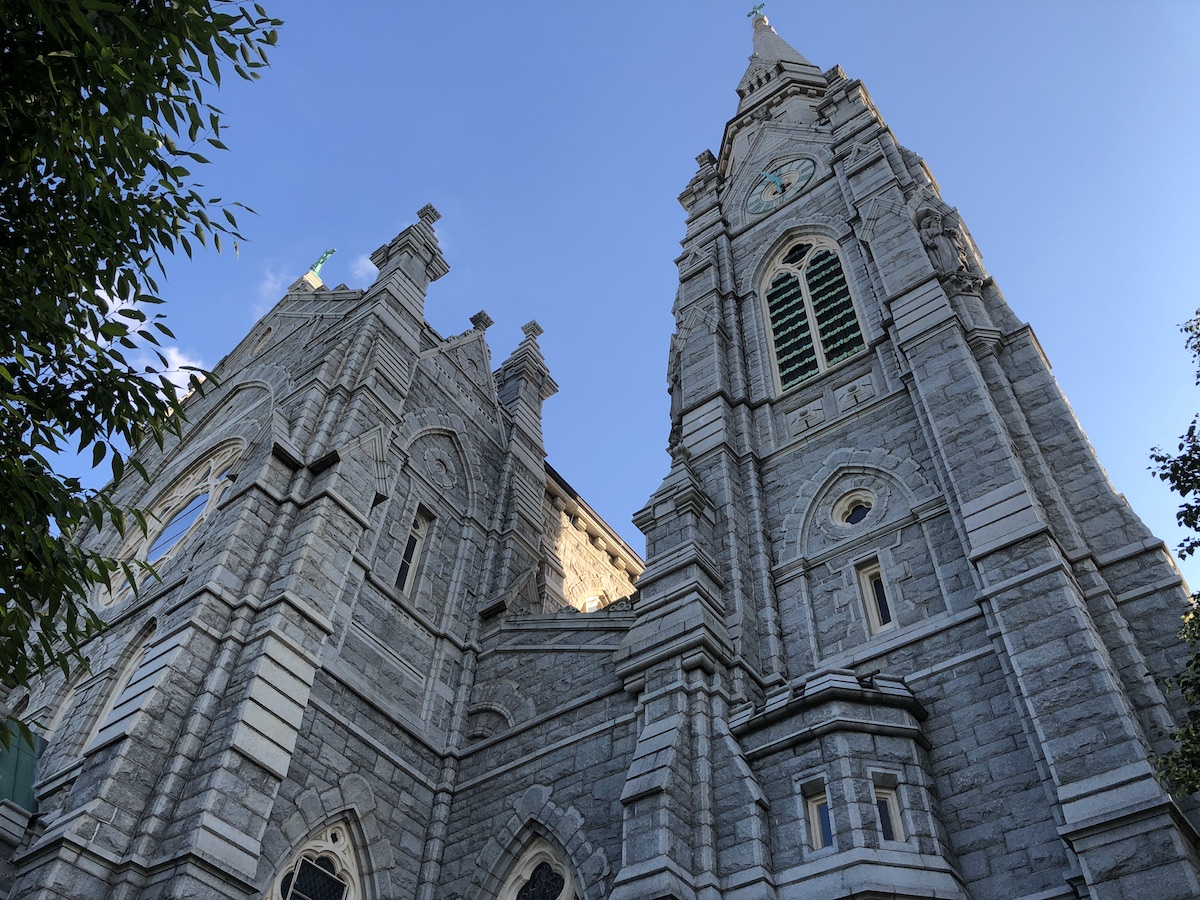 Longtime residents of Bolton Hill don’t hear them anymore, for they have become part of our unconscious soundscape. But newcomers notice them and wonder where they came from.
Longtime residents of Bolton Hill don’t hear them anymore, for they have become part of our unconscious soundscape. But newcomers notice them and wonder where they came from.
The Corpus Christi Church bells have tolled in Bolton Hill since the late nineteenth century. The first Corpus Christi bell likely tolled for the first time on January 1, 1891, when the church was completed and consecrated.
The original church steeple of Corpus Christi, much smaller than the one we see now, held the first bell, which weighed 2,500 pounds and was tolled by a rope. About the size of the Liberty Bell in Philadelphia, it was cast by the McShane Bell Foundry, located at Holliday and Centre Streets in Baltimore.

In 1912, a huge mechanical clock was installed, visible from all four sides of the church and a local landmark. It was run by weights and had to be hand-cranked. The clock’s mechanism activated the chiming of four new bells that were hung in the tower, weighing between 700 and 3,000 pounds each. All four bells were again cast by McShane.
The new bells began calling the Westminster Quarters every quarter-hour. The full hour chime is followed by one strike for the number of the hour.
The old 1890 bell was placed on the bell-platform underneath the four new bells, about halfway up inside the steeple, and was connected to a 7-foot-diameter wooden wheel that could be turned by a rope pull. It had nothing to do with the clock or telling time, but continued to be used for years to sound deaths or emergencies.
The new bells also commenced to toll the Angelus three times a day, at 6:04 a.m., 12:04 p.m., and 6:04 p.m. The Angelus bell, a practice that dates back to at least the fifteenth century, derives its name from the first words of the prayer commemorating the incarnation, “Angelus Domini nuntiavit Mariæ” (“the Angel of the Lord declared unto Mary”). It consists of a triple stroke repeated three times, with a pause between each set of three, and is often followed with additional tolling. At Corpus Christi the Angelus is concluded with a group of twenty fast peals.
The bell is used—in theory at least—to call people to prayer and to spread this good news to everyone.
And every evening at 7:04 p.m. the bells started tolling the De Profundis bell, introduced by Pope Urban II in 1095, an invitation to pause and pray for the dead at the end of the day. De Profundis refers to the opening verse of Psalm 130, in which the psalmist cries out to God “from the depths.”
According to one ecclesiastical publication of the time, no definite rule exists for the manner of ringing the De Profundis, except perhaps that it should allow enough time for the recitation of the psalm.
At Corpus Christi we first hear nine strikes, then five, and finally three, with a pause between each set. The De Profundis still holds a special meaning for the Corpus Christi parish because the chimes are a daily reminder of the 23 parishioners who died during a parish picnic outing at Tivoli on July 23, 1883 (subject of a future “Long Ago and Right Here” column, we hope).
The hand-cranking system of the Corpus Christi clock was eventually electrified, but until the end of the twentieth century, someone still had to climb the tower a few times a year to make adjustments, reset the clock if power went out, or at the beginning and end of daylight savings time. Gil Blake, a Corpus Christi parishioner and John Street resident, took up this volunteer duty for many years.
But the bells gradually declined, and they fell completely silent when the steeple was repointed in 2001 because the foundation on which the bells rested had become unstable. A restoration of both the clock and bell tower was required and took place in 2005. According to a church history published that year, all of the hands on the clock’s four faces—“some damaged, some missing”—were replaced, and the electrical clock (which itself had replaced the mechanical clock years before) was replaced by an atomic one.
The history noted, however, that “all extant parts of the original clock have been stored in case future generations might be interested in them.”

The new atomic clock syncs by satellite every day and automatically adjusts to daylight savings time. The bells are fully automated, are programmed electronically, and can be operated by remote control for weddings and funerals.
Since 2005, the Corpus Christi bells have played on the following schedule: Angelus bells are played at 7 a.m., 12:10 p.m., and 6:10 p.m.; De Profundis bells are played at 7:10 p.m., and the Westminster chimes toll each quarter-hour, half-hour, and hour starting at 7 a.m. and ending at 8 p.m.
The next time you hear the Angelus bells strike, remind yourself to deliver some good news, and in the evening at the time of the De Profundis, take a moment to remember those we have lost–perhaps at one of the neighborhood’s newer landmarks, Ana’s Garden at Mosher and Mason Streets.
